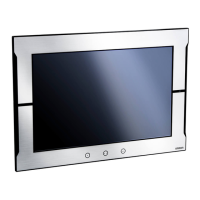
Do you have a question about the Omron NA5-15W101S-V1 and is the answer not in the manual?
| Touch Technology | Analog Resistive |
|---|---|
| Operating System | Windows Embedded Compact 7 |
| Power Supply | 24 VDC |
| Brightness | 400 cd/m² |
| Backlight | LED |
| USB | 2 ports (USB 2.0) |
| Operating Temperature | 0 to 50°C |
| Storage Temperature | -20 to 60°C |
| Resolution | 1024 x 768 pixels |
| Connectivity | Ethernet, USB |
| Ethernet | 10/100 Mbps |
| Protection Rating | IP65 (front) |
Specifies the target audience for this manual, requiring knowledge of electrical systems.
Lists the NA-series programmable terminals that this manual covers.
Details the visual elements and their meanings within the manual's layout.
Introduces the NA-series programmable terminals and their key features.
Describes how the NA-series terminals connect to other devices and software.
Lists the NA units and optional products available for the series.
Provides detailed technical specifications for the NA-series terminals.
Details the components and functions of the NA units.
Explains the use, specifications, and applications of SD memory cards.
Covers the use, specifications, and applications of USB memory devices.
Introduces the support software used for NA-series terminals.
Describes error states and operations following an error.
Provides methods for identifying and correcting errors.
Explains the notation used for safety warnings and precautions.
Defines the meaning of various symbols used in safety instructions.
Details panel requirements and mounting procedures for UL standards.
Introduces the NA-series programmable terminals and their key features.
Describes how the NA-series terminals connect to other devices and software.
Lists the NA units and optional products available for the series.
Provides detailed technical specifications for the NA-series terminals.
Details the components and functions of the NA units.
Explains the use, specifications, and applications of SD memory cards.
Covers the use, specifications, and applications of USB memory devices.
Introduces the support software used for NA-series terminals.
Describes the NA Unit's behavior during power cycling.
Outlines safety measures to prevent hazardous situations.
Provides detailed instructions for installing the NA units.
Explains how to wire power supply and other connections.
Covers environmental considerations for installing the NA unit in a control panel.
Explains the system program's role and unit startup states.
Details the procedure for recovering the NA Unit to its default state.
Provides an overview of the NA Unit's system menu and its functions.
Explains how to use the troubleshooter for Controller errors.
Describes how to view active and historical user alarms.
Covers settings for system menu behavior like double-tap intervals.
Details options for printing or capturing screens.
Explains how to configure buzzer notifications for touch input and alarms.
Describes how to view operation logs recorded by the NA unit.
Details the Safety Monitor function for monitoring safety control units.
Allows setting the date, time, and NTP server synchronization.
Enables setting the system and user languages.
Configures network interfaces like Ethernet, FTP, VNC, and FINS.
Adjusts the screen brightness of the NA unit.
Manages transferring projects and data to/from the NA unit.
Provides tools for checking hardware components like touch panel and LCD.
Displays product-specific information such as model and lot number.
Describes error states and operations following an error.
Provides methods for identifying and correcting errors.
Outlines routine checks and maintenance tasks for the NA unit.
Details the procedure for replacing the internal battery.
Provides detailed physical dimensions of the NA units.
Lists optional products and accessories for the NA-series terminals.